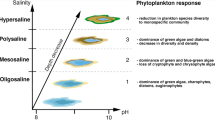Abstract
Hydrochemical and biogeochemical processes in Lake Khilganta were studied during more than ten years. The lake was shown to pass through periods of wetting and drying. This is accompanied by considerable changes in water chemistry and microbiological processes. During the passage from a wet to a dry period, lake water mineralization increases from 40 to 260 g/l and pH decreases from 9.9 to 7.1. At the same time, the isotope composition of organic matter carbon in bottom deposits becomes lighter (from −15.6 to −30.6‰), as well as that of carbon in carbonates (from +4.1 to −8.6‰), due to the lower rate of photosynthetic processes in lake bacterial mats. The order of salt precipitation during the passage from a wet to a dry period and the mechanism of maintaining water pH are considered. A possible similarity between the modern processes in Lake Khilganta and the processes in analogous Pre-Cambrian water bodies is discussed, and the hypothesis regarding the possibility of wider development of soda water bodies at early stages of Earth’s history is considered.
Similar content being viewed by others
References
Alekin, O.A., Semenov, A.D., and Skopintsev, B.A., Rukovodstvo po khimicheskomu analizu vod sushi (Handbook on Chemical Analysis of Continental Water), Leningrad: Gidrometeoizdat, 1973.
Vlasov, N.A. and Filippova, G.R., Physicochemical Characteristic of Mineral Lakes in Southeastern Transbaikalia, in Geokhimiya i gidrokhimiya prirodnykh vod Vostochnoi Sibiri (Geochemistry and Hydrochemistry of Natural Water in Eastern Siberia), Irkutsk: Vost.-Sib. kn. Izd., 1973, pp. 3–57.
Gerasimenko, L.M., Mityushina, L.L., and Namsaraev, B.B., Mats from Misrosoleus from Alcalophilic and Halophilic Communities, Mikrobiologiya, 2003, vol. 72, no. 1, pp. 84–92.
Gorlenko, V.M., Namsaraev, B.B., Kulyrova, A.V., et al., Activity of Sulfate-Reducing Bacteria in Bottom Sediments of Soda Lakes in Southeastern Transbaikalia, Mikrobiologiya, 1999, vol. 68, no. 5, pp. 664–670.
Dannye Upravleniya Gidrometeosluzhby po Zabaikal’skomu krayu (Data of the Deparatment of Hydrometeoservice for Transbaikalian Territory), http://pogoda.ru.net
Dzyuba, A.A. and Kulagina, N.V., Formation and Distribution of Salt Lakes in Pribaikal’e and Zabaikal’e Regions, Vodn. Resur., 2005, vol. 32, no. 1, pp. 13–17 [Water Resour. (Engl. Transl.), vol. 32, no. 1, pp. 8–12].
Esikov, A.D., Mass-spektrometricheskii analiz prirodnykh vod (Mass-Spectrometric Analysis of Natural Water), Moscow: Nauka, 1980.
Zavarzin, G.A., Epicontinental Soda Water Bodies as Supposed Relic Biotopes of Terrestrial Biota Formatioin, Mikrobiologiya, 1993, vol. 62, no. 5, pp. 789–800.
Zavarzin, G.A. and Zhilina, T.N., Soda Lakes as a Natural Model of Ancient Continental Biosphere, Priroda (Moscow, Russ. Fed.), 2000, no. 2, pp. 45–55.
Zavarzin, G.A., Zhilina, T.N., and Kevbrin, V.V., Alkalophilic Microbial Community and Its Functional Diversity, Mikrobiologiya, 1999, vol. 68, no. 5, pp. 579–599.
Kozerenko, V.N., Geologicheskoe stroenie yugo-vostochnogo Zabaikal’ya (Geological Structure of Southeastern Transbaikalia), Lvov: Izd. L’vovskogo univ., 1956.
Kompantseva, E.I., Sorokin, D.Yu., Gorlenko, V.M., et al.,Phototrophic Community of the Salt Soda Lake Khilganta, Mikrobiologiya, 2005, vol. 74, no. 3, pp. 410–419.
Kuznetsov, S.I., and Dubinina, G.A., Metody izucheniya vodnykh mikroorganizmov (Methods for Studying Aquatic Microorganisms), Moscow: Nauka, 1989.
Metody mineralogicheskikh issledovanii. Spravochnik (Methods for Mineralogical Studies: Reference Book), Ginzburg, A.I., Ed., Moscow: Nedra, 1985.
Namsaraev, B.B. and Namsaraev, Z.B., Microbial Processes in Carbon Turnover and Habitat Conditions in Alkaline Lakes of Transbaikalia and Mongolia Tr. Inst. Mikrobiologii RAN, 2007, no. 14, pp. 299–322.
Obyazov, V.A., Variations in Air Temperature and Humidity in Transbaikalian Territory and Near-Border Areas of China, in Mater. konf. “Prirodookhrannoe sotrudnichestvo Chitinskoi oblasti (RF) i Avtonomnogo raiona Vnutrennyaya Mongoliya (Kitai) v transgranichnykh ekologicheskikh raionakh” (Mater. Conf. “Nature Protection Cooperation between Chita Province (RF) and Autonomous Region Inner Mongolia (China) in Transboundary Ecological Regions), Chita, 2007, pp. 247–250.
Pimenov, N.V., Lunina, O.N., Prusakova, T.S., et al., Biological Fractionation of Stable Carbon Isotopes at the Boundary between Aerobic and Anaerobic waters in Meromictic Water Bodies, Mikrobiologiya, 2008, vol. 77, no. 6, pp. 839–847.
Semikhatov, M.A., Raaben, M.E., Sergeev, V.N., et al., Biotic Events and Positive Isotopic Anomaly of Carbonate Carbon 2.3–2.06 Billion Years Ago, Stratigrafiya. Geokhimicheskaya Korrelyatsiya, 1999, vol. 7, no. 5, pp. 3–27.
Solomin, G.A. and Krainov, S.R., Alkali Constituents of Alkaline Natural Water and Sewage: Geochemistry of Neutralization by Acidic and Near-Neutral Groundwaters, Geokhimiya, 1998, no. 2, pp. 183–201 [Geochem. Int. (Engl. Transl.), no. 2, pp. 150–167].
Sodovye ozera Zabaikal’ya: ekologiya i produktivnost’ (Soda Lakes of Transbaikalia: Ecology and Productivity), Alimov, A.F., Ed., Novosibirsk: Nauka, 1991.
Florensov, A.A., Some Features of Large-Lake Beds in Southern Siberia and Mongolia, in Mezozoiskie i kainozoiskie ozera Sibiri (Mesozoic and Cenozoic Siberian Lakes), Novosibirsk: Nauka, 1968, pp. 58–73.
Bryantseva, I., Gorlenko, V.M., Kompantseva, E.I., et al., Thiorhodospira Sibirica Gen. Nov., Sp. Nov., a New Alkaliphilic Purple Sulfur Bacterium from a Siberian Soda Lake, Int. J. Syst. Bacteriol., 1999, vol. 49, pp. 697–703.
Hardie, L.A. and Eugster, H.P., The Evolution of Closed-Basin Brines, Mineral. Soc. Am. Spec. Publ, 1970, vol. 3, pp. 273–290.
Author information
Authors and Affiliations
Additional information
Original Russian Text © Z.B. Namsaraev, V.M. Gorlenko, S.P. Buryukhaev, D.D. Barkhutova, V.D. Dambaev, L.E. Dulov, V.V. Sorokin, B.B. Namsaraev, 2010, published in Vodnye Resursy, 2010, Vol. 37, No. 4, pp. 477–483.
Rights and permissions
About this article
Cite this article
Namsaraev, Z.B., Gorlenko, V.M., Buryukhaev, S.P. et al. Water regime and variations in hydrochemical characteristics of the soda Salt Lake Khilganta (Southeastern Transbaikalia). Water Resour 37, 513–519 (2010). https://doi.org/10.1134/S009780781004010X
Received:
Published:
Issue Date:
DOI: https://doi.org/10.1134/S009780781004010X




